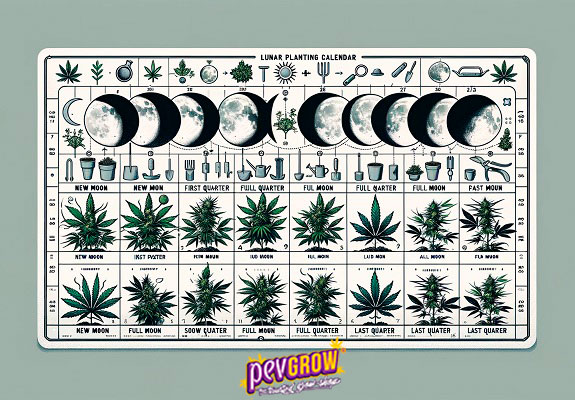

06-05-2024 08:00:35 - Updated: 6 May, 2024
The cultivation of plants, taking into account the moon is one of the basic principles of biodynamic agriculture, and in this post I will give you all the keys so you can get the highest productivity and quality with your normal flowering or autoflowering seeds taking into account the different phases of the moon.
Before starting, I want to present you the free cellphone app “2019 Marijuana Lunar Calendar” without a doubt is the best way to know in a clear and updated way which days are most suitable to do any action related to cannabis.
You can download our moon calendar in Android and IOS. With it not only you will know which days are more propitious to germinate, to fertilize, to harvest, to treat illnesses etc… but also you will be able to put personalized notes and to create warnings, this way you will increase the possibilities of harvesting the best grass thanks to the lunar influence.
And now yes, let’s know in detail how the moon affects marijuana plants.
⭐ Moon Cycles
The elliptical movement of the moon makes it vary its distance from the earth, to see it you just have to look at an exact point at the same time, the next day you can see you looking at the same point, in the same space of time, if the moon has ascended or descended.
– Ascending Moon:
The liquids ascend, the sap rises to the upper parts of the plant, it is the perfect stage to cut the cuttings and prepare them. At this stage you should avoid harvesting cannabis, as it is a plant that needs to be dried.
– Descending Moon:
It’s the best moon phase to plant seeds. Liquids flow downward, increasing the activity of the underground part of the plant, so it’s a good time to do tasks with the roots, germinate seeds, or plant them. It is also a good time to do soil enrichment work.
The plants’ sap moves constantly inside them. But when the moon is in descending phase, its magnetism tends to push, to promote the activity in the lower part of the plants. However, when the Moon is in the ascending phase, this activity is more concentrated in the upper part, and this factor is especially important in defining the work to be done at each moment in our garden.

⛳ Moon Phases
– New moon:
This phase begins when the moon ceases to be visible from the earth, and ends when the right half is fully illuminated. It is recommended not to work the plants on the same day as the new moon, but you can prune the diseased plants.
– Crescent moon:
It is the phase that takes place between the new moon and the full moon, it can be distinguished very well because it acquires a form of letter D if you see it from the northern hemisphere, increasing the internal activity of the plant and strengthening it against pests and diseases, and it is not recommended to prune during this period.
– Full moon:
In this phase the moon is completely illuminated, and the sap rises to the upper parts of the plant, so pruning is not recommended, and is also perfect for germinating seeds.
– Dwindling Moon:
It can be easily recognized by its C shape if you look at it from the northern hemisphere. During this stage, the sap goes down to the lower parts and the soil is much more receptive, so it is perfect for fertilizing, watering or harvesting, since the aromas, flavors and medicinal properties of cannabis are better preserved at this stage. Planting, sowing or transplanting is not recommended when the moon is waning.
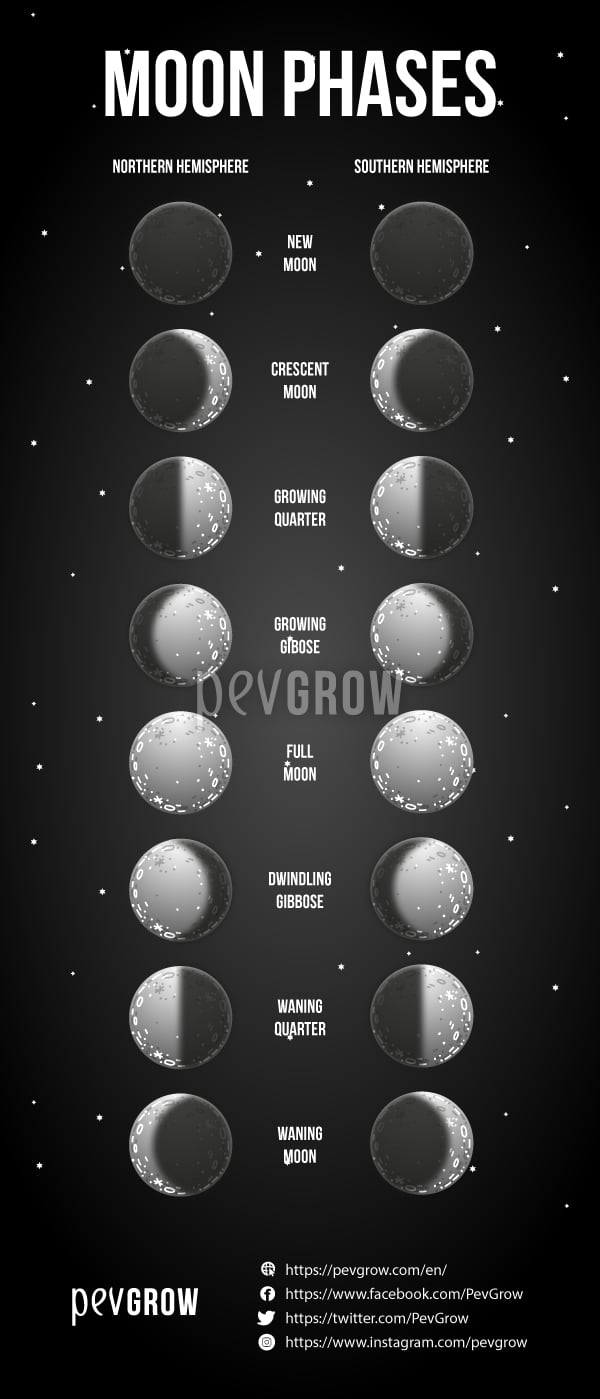
In the northern hemisphere, dwindling Moon is C-shaped and rising Moon D-shaped. To better remember this, think of the Moon as a liar and when rising it looks like a D and when decreasing it looks like a C. (To avoid confusing decreasing with descending, we call the decreasing Moon dwindling).
In the southern hemisphere, however, the crescent moon is C-shaped and the dwindling moon is D-shaped. The Moon lights differently when you look at it from one hemisphere or another, but the synodic lunar revolution, which is how this cycle of the Moon is called, does not change.
The most important change between the northern and southern hemispheres takes place in the periodic Lunar revolution, that is, between the ascending and descending cycles. When in the northern hemisphere the Moon is in a descending phase, in the southern hemisphere it will be in an ascending phase, and vice versa.
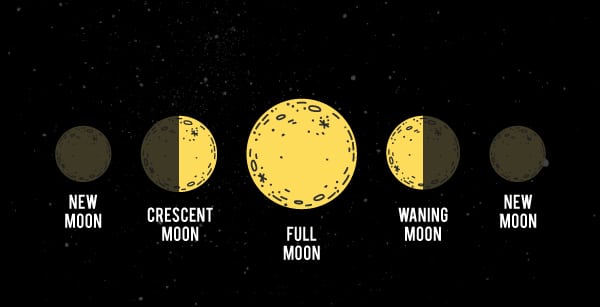
✨ Tidal Effects
Every day we have 2 high and 2 low tides, one in the morning and one in the afternoon. The influence of the low tide in the afternoon is more powerful than the one in the morning. However, the influence of the morning high tide is stronger than the one in the afternoon.
It takes approximately 6 hours and 12 minutes to go from high to low tide, between which the tide can be considered falling or ebb tide. As it takes the same time to go from low tide to high tide, and that interval is called rising or flood tide.
When tide is rising or flood it is the right time to graft, work hard soils, compost or harvest if it happens to be on a waning moon.
And when tide is falling or ebbing, it is the best time to sow if it is at the same time as ascending Moon, to transplant, to work loose soil, to spread fertilizer and manure.
What is the most influential domain on The Earth?
It depends on our latitude; in Europe, for example, the ascending or descending cycle has the greatest influence. But the closer we get to the equator, the lower the incidence of this factor, and the greater the influence of the increasing or dwindling phase.
Another factor that must be taken into account before carrying out any work on our plants, along with the Moon, are the constellations (Fire, air, water and earth).
The moon cycle based on constellations
Planting according to the signs makes the difference. When the moon passes through which constellation, influences the part of the marijuana plant associated with that constellation. To know them better and to know how the constellations influence in your culture of marijuana, get with a biodynamic calendar, that groups them based on 4 elements of the nature and as consequence to certain signs of the zodiac:
– Aries, Leo and Sagittarius: They are constellations of Fire, and it is without a doubt the best moment for the seeds.
– Geminis, Libra and Aquarius: They are the known as constellations of Air, and it is the best moment for the flowers of the plant, it is here where it is recommended to carry out all the tasks of plantation and culture.
– Cancer, Scorpio and Pisces: They are the constellations of Water, it is when the leaves and stems grow more, important because at the time of making the plantation.
– Taurus, Virgo and Capricorn: They are the constellations of Earth, and it is the best moment for everything related to the roots, so much for its growth, as for getting rid of the sick ones and that this way it can grow stronger and healthier.
| Aries | Fruit | Ascendant |
| Taurus | Root | Ascendant |
| Gemini | Flower | Descendant |
| Cancer | Leaf | Descendant |
| Leo | Fruit | Descendant |
| Virgo | Root | Descendant |
| Libra | Flower | Descendant |
| Scorpio | Leaf | Descendant |
| Sagittarius | Fruit | Ascendant |
| Capricorn | Root | Ascendant |
| Aquarius | Flower | Ascendant |
| Pisces | Leaf | Ascendant |
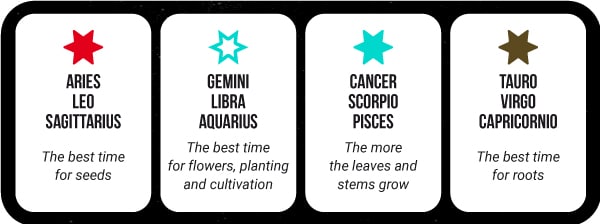
👌 Daily rhythms
Earth energies vary depending on the season. In spring, when the sun is rising, the Earth exhales and the vitality of the Earth ascends outwards. However, in Autumn, when the sun is descending, the earth breathes in and revitalizes. In the Moon we can also find these energies, the ascending Moon is called Lunar Spring, and the descending Lunar Autumn.
Every day this phenomenon is repeated, in the morning the energies rise and the Earth exhales, so it is the ideal moment to sow or harvest. In the afternoon the energies descend and the Earth breathes in, so it is better to plant, transplant or prepare the substrate.
During midday and early afternoon it is recommended not to perform important tasks, between 12 and 15 hours.
🚀 Growing marijuana with the lunar calendar in mind
First of all it must be clarified that this guide is intended for cannabis growers who want to harvest buds. With this aim we look for the days considered as best to get flower of each month. In the case of wanting to produce seeds, it would be necessary to look for the best days thinking about harvesting fruits.
We have discussed this cultivation calendar with several experts and have found that there is no unanimity in deciding which days are best for which tasks. That is why we tried to interpret Michel Gros’s Lunar Calendar, adapting it to the requirements of cannabis growers.
Prepare the substrate
Especially in outdoor crops where it is going to be planted in the motherland. When we are going to make the mixture, we will try to have the descending Moon, between fourth waning and new Moon phase, coinciding with the earth constellation (Root).
Germination
Germination is recommended during descending moon, within the 3 days previous to full moon, since it will favor the growth of larger and more aromatic flowers. It is recommended to combine with an earth constellation (Root).
Transplants
They are the most critical moments of any crop and the moment when the power of the Moon over the earth is most important. In this case it is necessary to try to match the descending Moon, in its crescent phase, with an air constellation (Gemini, Libra or Aquarius).
Foliar and root fertilization
If we fertilize by pulverizing the leaves, we must try to do it on a day defined as leaf, and ascending and crescent Moon. On the other hand, if we add fertilizers to the irrigation, we will have to look for a day defined as root or flower, and descending and crescent Moon. Fertilizing is always better in the morning than in the afternoon, and never in fire signs.
Pruning of different types
For aerial pruning designed to improve performance, it is best to do it in flower day, with descending moon and in waning phase. If it is a pruning of roots it is better to choose root day, with descending moon and waning phase. For a low pruning the best thing would be to choose a flower day, with descending moon and waning phase.
Getting out cuttings
When you have to take out cuttings, try to make it on a flower day, with ascending Moon and waning or increasing phase.
Planting cuttings
At the moment of planting, you must wait until the descendant Moon begins and its increasing phase, with fire constellation if possible.
Branches bending or L.S.T.
It is necessary to try to stress the plants the minimum during this task. If we do the moulding during the growth it is better that it coincides with crescent and ascending Moon, in a water constellation (Leaf).
If we do it in flowering it is better to do it in waning and ascending Moon, with an air constellation (Flower).
Preventing or treating with insecticides and fungicides
For pulverized preventive treatments the whole ascending phase is valid, better in crescent, and in leaf days, insecticides in the morning and fungicides in the afternoon. For systemic products to be used in irrigation, better in descending and waning moon, and in root days.
Harvesting
The ideal option is to wait for a flower day, with descending and waning moon, if possible in the morning, coinciding with low tide. This benefits plants that are consumed dry.
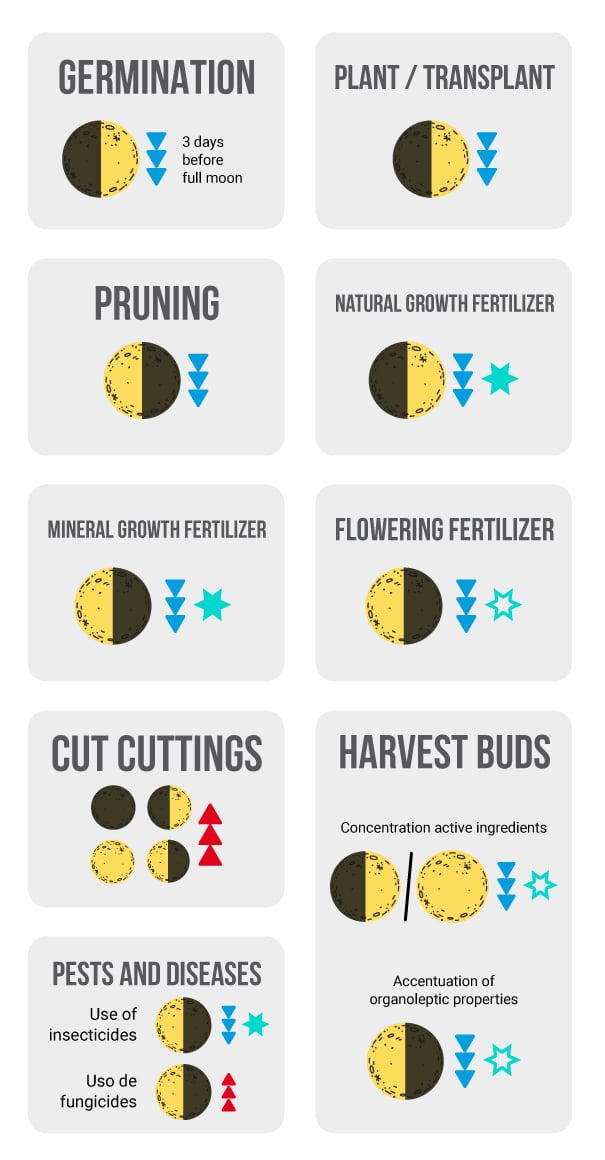
Download in PDF the lunar calendar 2024 for the Northern hemisphere.
Download in PDF the lunar calendar 2024 for the Southern hemisphere.
✅ Conclusion
How does the moon affect plants? In this article you have been able to know all the influences that the moon has on marijuana plants, and how to cultivate it taking into account the different phases of the moon and its passage through the different constellations. Elevate the productivity of your culture of marijuana to the maximum, cultivating on the basis of the lunar calendar 2019!
If you liked it, share in social networks I will be eternally grateful to you! Don’t forget to comment on your experience in the comments section, you’ll get great rewards redeemable in our Growshop online!
Remember to download our App! A free cannabis lunar calendar!
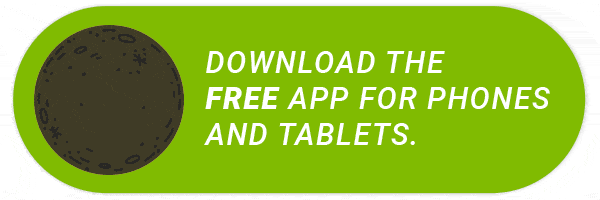


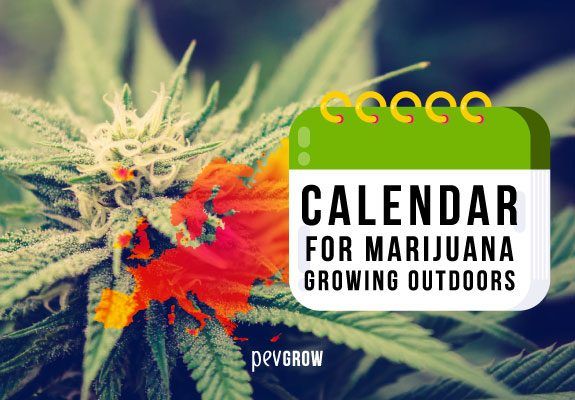

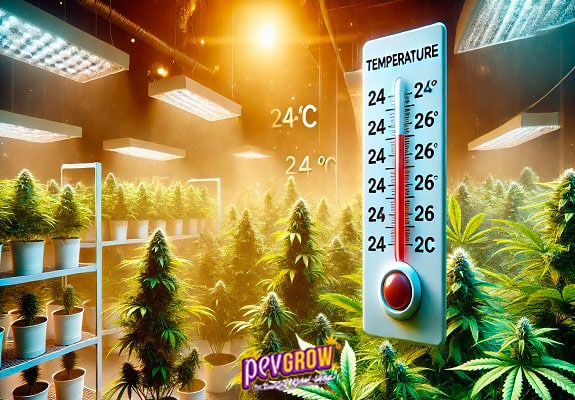

Everything awsome but looks like you’ll made the lunar calendar setup more complicated but can see have more info for sure … rather the old calendar design.but been using for year N works great.
This is good info, I am going to try working with. The calendar I printed is too small to read easily. This info would be great if it was part of a day planner book.
Also the numbers for the days on the calendar are one digit off. The calendar says today is Wednesday June 25,2020 but it’s actually Wednesday June 24. The moon sign for Saturday is correct, I didn’t check any others.
Hi, Greg!
We love to hear from you, we are working on a new version for the PPP, thanks for the feedback
For germination I see May 4-5 2020 are 2 good days.
But does germination mean the day I put the seed into a paper towel to sprout it (May 4), and after 2 days, place it into the soil (May 6)?
Or should I sprout the seed on May 2nd to place the sprouted seed into the ground on May 4th?
Thank you
Hello Eric, it means those days are ideal for germination.
Thanks to you.
God bless you for creating this amazing resource! Will definitely be applying this for my next grow.
Wanted to ask – in the calendar, what does “Rest” mean? (The blue shaded icons)
Does it mean to chill that day? Or not do anything to the plant? Just trying to understand.
Hello friend, On days off we recommend that you do not do anything to the plant unless it is necessary.
Thank you.
Further to my earlier post, I thought it expedient to do a follow up experiment to validate my comments. Firstly, I live in the southern hemisphere – southern Australia to be more specific and obviously the lunar times will be different to the Northern hemisphere, but not the effects of the same moon phases on the plants. Secondly, when I quote the times for the seedlings to “hatch”, I count the days until the seedlings open their leaves, for until they do so, they are not really living on their own yet. Generally 12-24 hours earlier is when they first emerge to the surface. Thirdly, for the results to be scientifically valid, all tests had to be as identical as possible. To this end I used 40x40x40 millimetre Rockwool cubes as the growing medium. All the seeds came from my own breeding program undertaken last Summer and all seeds came from the same mother plant. In this case, the mother/seed plant was a Mandala Seeds photo/reg pure female “Eight Miles High”. The father/pollen plant was a Mr. Nice Seedbank pure male photo/reg male “G13 Widow”. No chemicals were used at any time throughout their lives nor was any type of manipulation performed in order to produce the seeds. (Just as nature intended!) To create the seeds, individual flowers were hand pollinated with a small paint brush with pollen that was harvested/collected from the father plant growing some distance away. This way only a few flowers had seeds, leaving the rest of the plant “sinsemilla”.
Five seeds were planted at each phase – 2 days after the New Moon, 2 days after the First Quarter, 2 days after the Full Moon and 2 days after the Third Quarter. All seed/cube combination were left at the same place in my kitchen with more or less the same temperatures throughout the month the experiment took place (end of November to end of December 2019) and exactly the same germination methods/conditions were used. This involved the moistened cubes sitting on a large saucer that had a layer of fine aquarium gravel on the bottom. The gravel provides air circulation so that the cubes are not effectively sealed at their base by being in direct contact with the saucer. The water used was also as identical in quality as possible. All seeds chosen for the experiment were hand selected from the 400-500 I have of this strain and were deemed by me as “prime” looking seeds with great potential.
********************** Now for the results of my experiment !! ********************
New Moon – 5 out of 5 grew; 4 taking 4 days and 1 taking 5 days until they were up and opened.
First Quarter – 5 out of 5 grew; all taking 5 days until up and opened.
Full Moon – 4 out of 5 grew; 2 taking 5 days and 2 taking 6 days until up and opened.
Third Quarter – 1 out of 5 grew taking 7 days until up and opened. 2 more seeds did emerge after 9 days but did not grow or open; and 2 did not sprout/emerge at all.
Although this experiment would need to be much larger or repeated many more times to be statistically and scientifically valid, I think we can draw some conclusions from the data. Personally, I always plant in the First Quarter as my first preference and at the New Moon as my second preference. I have read other peoples’ comments in various forums complaining about poor germination rates of the XYZ seeds they have purchased and often wonder if their technique is lacking or if they have unfortunately planted during the Third Quarter? Using my own routines honed over the last ~35 years, I now expect to achieve germination rates of 95%+ and firmly believe that using the lunar planting system is integral to meeting this goal. Make of it what you will, however I am a huge advocate.
Finally and most of all – good luck and happy growing !
Bentos, thank you very much for sharing your experience, I recommend you to download our app so you can know all the news we have prepared this 2020.
Greetings.
You’re welcome, glad to be of help to the gardening community. Thank you, I have the app from last year already and urge all like minded growers to try some, if not all of your recommendations contained in the app. People should also be aware that these principals still apply to plants growing indoors, artificially under electric lights and hydroponically, just as they do to plants growing outdoors, naturally in the sun and soil. These principles were derived at over 100s of years of observations by people who were growing food for their utter survival and were not dreamed up via theoretical modelling using computer simulations!
It can not hurt to try something new and if your babies are happier, what are the drawbacks? I can tell you, there are none!
Further to this discussion, this year in one of my “research projects” growing outdoors in/with soil and in conjunction with using the moon cycles, I achieved a germination rate of 66 plants growing from 69 seeds planted.
I believe these results are an obvious endorsement for the Lunar Growing Calendar!
They are also a GREAT endorsement for shopping with Pev Grow!!
Remember; happier plants = bigger and better flowers!
With Kind Regards,
Bentos.
thank you so much Bentos 😉
2020 please
Hello, next week this article will be updated, remember that in our app you already have all the information of 2020, you can create notes and you have a lot of actions to do to your plants according to the influence of the moon.
Greetings
Hi, I first starting using the lunar cycle (and astrology) for germinating and now I try to do everything else (feeding, pruning, etc) referencing both calendars.
Does location matter when using your calendar? E.g. Northern vs. Southern hemisphere or Europe vs. North America
Hi,
the actions are the same regardless of which hemisphere you are in. You can download our App Lunar Calendar Cannabis, not only will you know the best days to germinate, fertilize, prune etc … but you can also set alarms and keep track in the agenda with all the data you want to include on your crop.
Thank you for your comment.
The actions are the same based on the moon calendar, your location on the globe however will dictate the phase of the moon, it’s rise and set times, and it waxes and wanes. In northern hemisphere the moon fills from right to left, a D shape is a waxing moon and a C shape is waning. In the south it is the exact opposite. I’m not sure if that affects the growth patterns.
WOW, thank you for explaining this so effectively. I have been using these principles for close to 30 years and can say it definitely works ! I encourage every one to try some, if not all of these recommendations, and judge the results for themselves. A simple experiment can be undertaken by simply planting a few seeds each moon phase and taking notes as to how long it takes for germination, seedling vigour / growth / strength and you will soon pick up on small differences. Obviously you must provide similar cultivation techniques for each batch of seeds to ensure valid results, I would suggest Rockwool cubes as being the easiest method to keep things on a level playing field. After this easy test, you will soon realise that these principals do work and I assure you that they transfer to all stages of the plants` life. It can not hurt to try something different can it ? And if your plants are happier because of it, they will also reward you for being extra kind to them !!